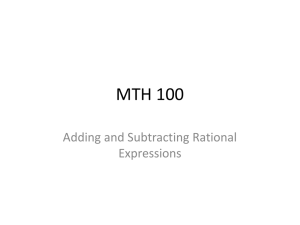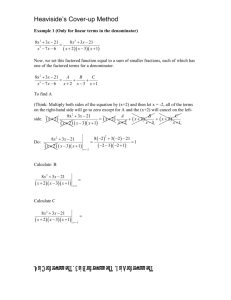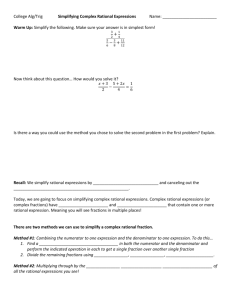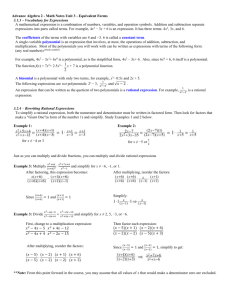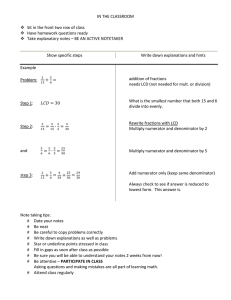Math 1010 - Lecture 20 Notes Dylan Zwick Fall 2009
advertisement
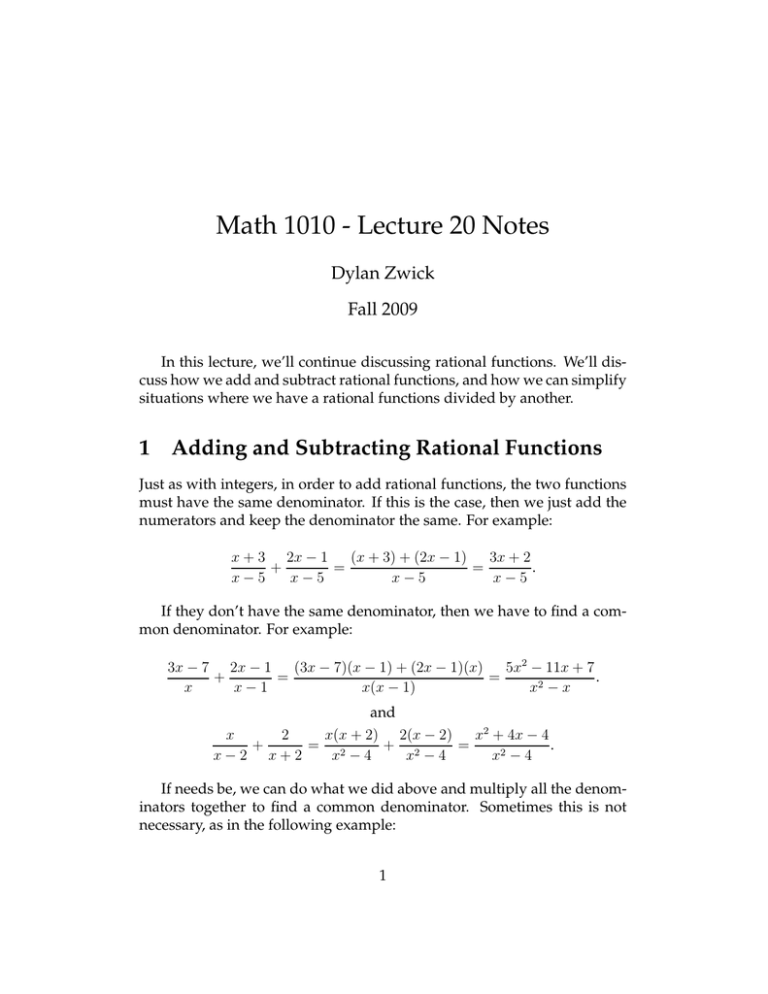
Math 1010 - Lecture 20 Notes Dylan Zwick Fall 2009 In this lecture, we’ll continue discussing rational functions. We’ll discuss how we add and subtract rational functions, and how we can simplify situations where we have a rational functions divided by another. 1 Adding and Subtracting Rational Functions Just as with integers, in order to add rational functions, the two functions must have the same denominator. If this is the case, then we just add the numerators and keep the denominator the same. For example: (x + 3) + (2x − 1) 3x + 2 x + 3 2x − 1 + = = . x−5 x−5 x−5 x−5 If they don’t have the same denominator, then we have to find a common denominator. For example: (3x − 7)(x − 1) + (2x − 1)(x) 5x2 − 11x + 7 3x − 7 2x − 1 + = = . x x−1 x(x − 1) x2 − x and x 2 x(x + 2) 2(x − 2) x2 + 4x − 4 + = 2 + 2 = . x−2 x+2 x −4 x −4 x2 − 4 If needs be, we can do what we did above and multiply all the denominators together to find a common denominator. Sometimes this is not necessary, as in the following example: 1 x2 x 2 x 2(x − 2) 3x − 4 + = 2 + 2 = 2 . −4 x+2 x −4 x −4 x −4 Here we noticed that our first denominator was a multiple of the second, and so we only had to multiply the second by something, in this case (x − 2), to get a common denominator. Finally, sometimes after you’ve added two rational functions together you’ll have a common factor in the numerator and the denominator, and you can factor it out. For example: x 2 x−2 1 − = = . x2 − 4 x2 − 4 x2 − 4 x+2 Note that we could not have factored an x − 2 term our of either of the terms on the left. Examples Calculate the following: 1. 6 3x − . x−8 8−x 2. 4 4 − 2 . 2 x x +1 2 3. 4. x2 1 x − . − x − 30 x + 5 3 1 − . x − 2 (x − 2)2 2 Complex Fractions With integers, if we’ve got one fraction divided by another: a b c, d then we can simplify this by multiplying the top and bottom by d, and then the top and bottom by b: = a b c d bd bd = ad . bc The same idea applies to polynomials. So, for example, if we have the expression: 3 x+1 x+2 x+3 x+5 If we multiply the top and bottom by (x + 2)(x + 5) we get: x2 + 6x + 5 (x + 1)(x + 5) = 2 . (x + 3)(x + 2) x + 5x + 6 Sometimes we’ll have to turn the numerator, denominator, or both into a fraction before we can simplify it. For example, if we’re given: 5 + x12 8 +x x we want to first write the top and bottom as rational functions: = 5x2 x2 8 x + 1 x2 x2 x + = 5x2 +1 x2 x2 +8 x . This we can then simplify by multiplying the bottom by = 5x2 +1 x2 x3 +8x x2 . Now the x2 terms will cancel out to give us: 5x2 + 1 . x3 + 8x Examples Simplify the following. 4 x x to get: 1. x2 +3x−10 x+4 2. 6x2 −17x+5 3x2 +3x 3. x2 +5x+6 4x2 −20x+25 3x − 6 3x−1 3x+1 x2 −5x−24 4x2 −25 . . 5

